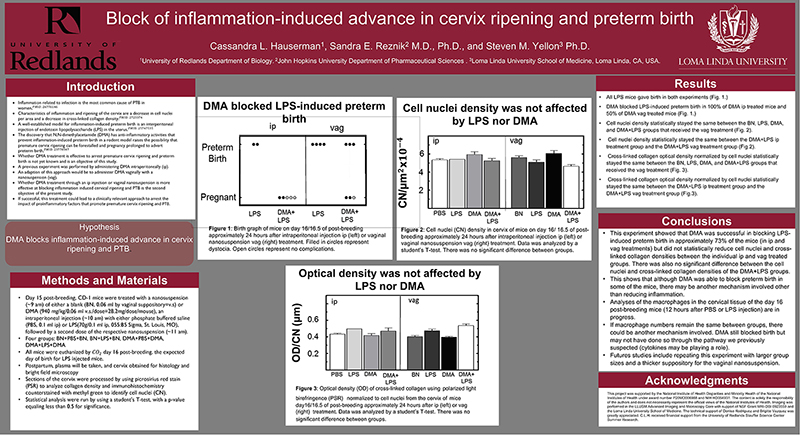Block of inflammation-induced advance in cervix ripening and preterm birth

Cassy Hauserman '21
Abstract
Inflammation related to infection is the most common cause of preterm birth in women. Remodeling of the cervix associated with preterm birth is characterized as an inflammatory process because of the breakdown of the cross-linked collagen fibers and reduced cell nuclei density that results from cellular hypertrophy and edema. A well-established model for inflammation-induced preterm birth is an intraperitoneal injection of endotoxin lipopolysaccharide (LPS) in the uterus. The discovery that N,N-dimethylacetamide (DMA) has anti-inflammatory activities that prevent inflammation-induced preterm birth in a rodent model raises the possibility that premature cervix ripening can be forestalled and pregnancy prolonged to advert preterm birth. The present study addresses the hypothesis that DMA will block cervical ripening that would occur in LPS mice within 24h of LPS injection. For controls, PBS/BN- and DMA-treated controls will remain pregnant past the expected preterm birth of LPS treated mice date (day 16) to term (day19) with no adverse effects. For the cervix of BN, DMA, and DMA+LPS treated mice, cell nuclei density will remain high and collagen cross-linking will remain high in the stroma compared to LPS mice with a ripened cervix. All LPS mice gave birth in both experiments and DMA blocked LPS-induced preterm birth in 100% of DMA ip treated mice and 50% of DMA vag treated mice. Based on the results, neither DMA nor LPS did not statistically reduce cell nuclei and cross-linked collagen densities between the individual ip and vag treated groups. There was also no significant difference between the cell nuclei and cross-linked collagen densities of the DMA+LPS groups. It is possible that there is another mechanism that DMA is effecting other than inflammation in the cervix.


